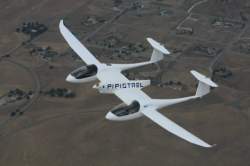An electrically powered 1930’s era Tiger Moth?
By Don | October 4, 2011
 With the 4 wings all finished now on my Tiger Moth project, and after attending a huge airshow in Wisconsin this summer (EAA’s Oshkosh show), I got the crazy idea – could I power my Tiger Moth on electricity? How cool would that be?!? The short answer is no – because energy storage isn’t there yet.
With the 4 wings all finished now on my Tiger Moth project, and after attending a huge airshow in Wisconsin this summer (EAA’s Oshkosh show), I got the crazy idea – could I power my Tiger Moth on electricity? How cool would that be?!? The short answer is no – because energy storage isn’t there yet.
But this past week, NASA (with Google sponsoring prize $$) had a competition under the CAFE (Comparative Aircraft Flight Efficiency) foundation with a top prize of $1,350,000 for the winner, to be announced on Monday (yesterday).
Because most of the aircraft were electric (or hybrid), I was very interested so Leslie (bless her!) and I went up over the weekend to see these e-airplanes. Who won?
Yesterday NASA had the competing aircraft on display at Moffett field, my old Navy stomping grounds, up in the Bay area. The plane that won was the Pipistrel, a venture between Penn State University and the Slovenian light aircraft company Pipistrel. I’d seen the plane on display this summer in Oshkosh and that’s what piqued my interest in the possibility of making my project electric.
A close runner-up in second place was the e-Genius, a team from the University of Stuttgart. It was fun talking to these teams (and the others) yesterday about the rapid advances being made in aviation. The next big push will be to break the sound barrier with an electrically powered airplane.
Efficiency is everything for an electric plane – thus all these aircraft were composite structures with glider like wings. Obviously, the Tiger Moth is extremely “draggy” with all the struts, etc, slowing things down so it’s a very poor candidate for electric power, but I still think (if possible) – it would be very cool!